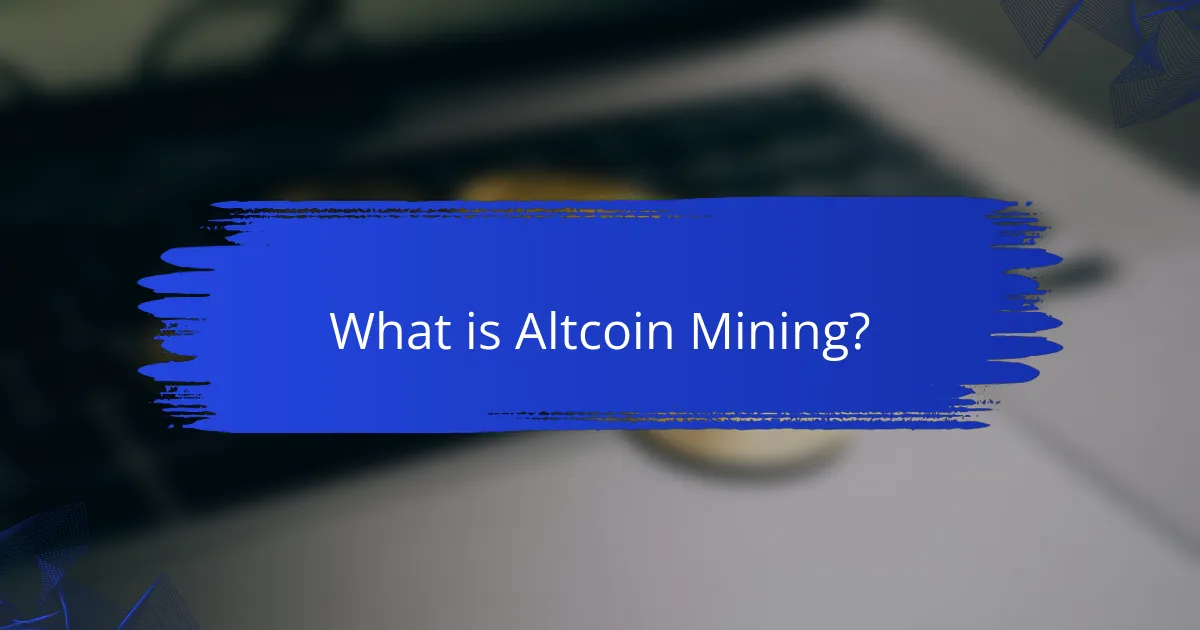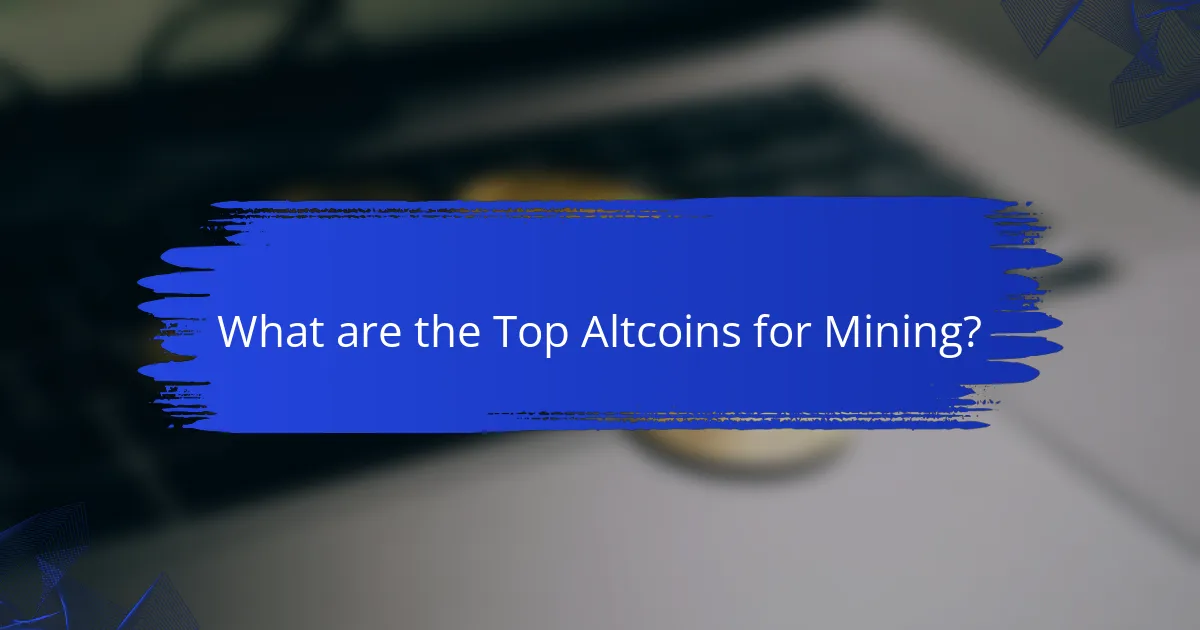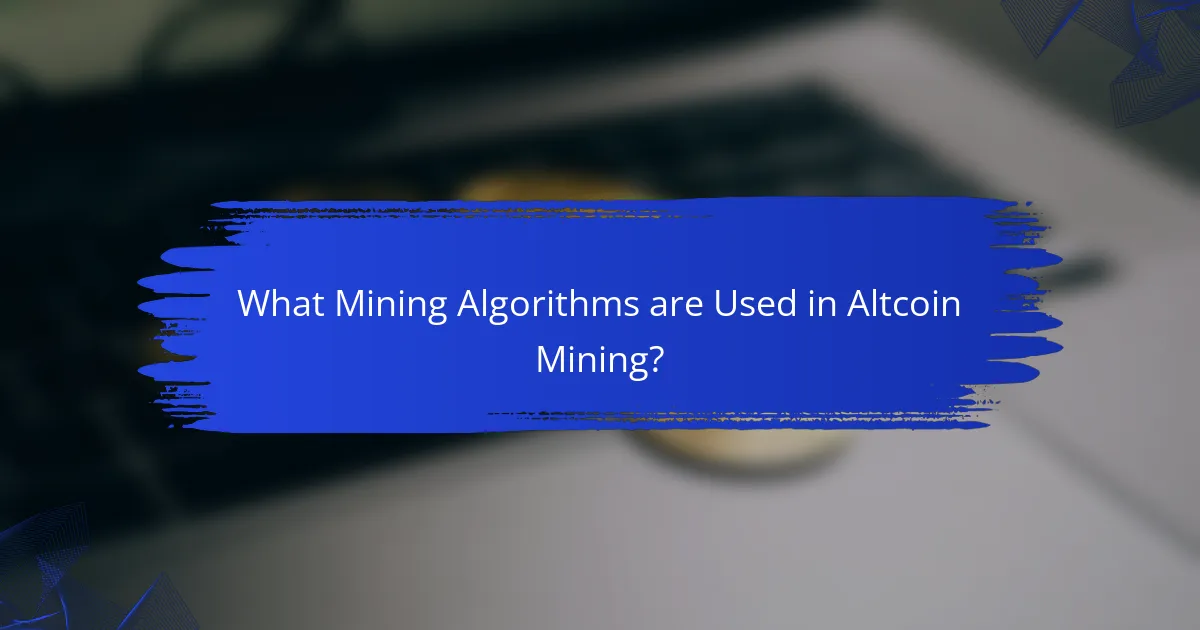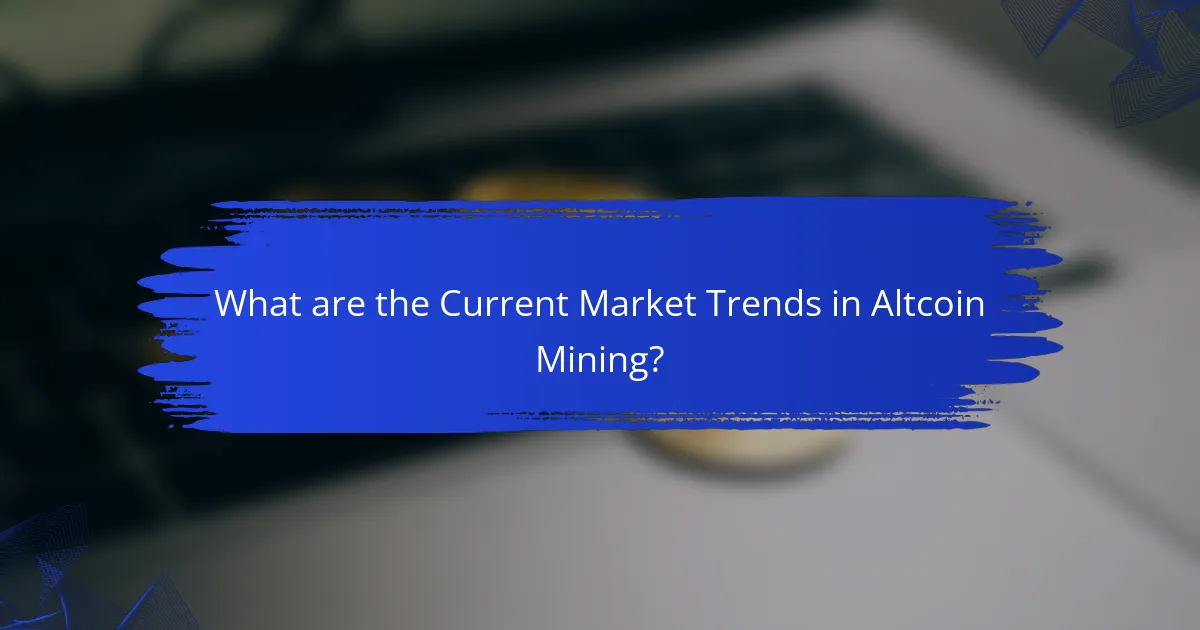Altcoin mining is the process of validating transactions and adding them to blockchains for cryptocurrencies other than Bitcoin. This article provides an overview of the top altcoins for mining, including Ethereum Classic, Monero, Ravencoin, and Litecoin, highlighting their unique mining algorithms such as Ethash, RandomX, KawPow, and Scrypt. It also discusses various mining algorithms like Proof of Work (PoW), Proof of Stake (PoS), and Delegated Proof of Stake (DPoS), detailing their characteristics and energy requirements. Additionally, the article examines current market trends in altcoin mining, including profitability fluctuations, energy efficiency, and the influence of decentralized finance (DeFi) projects on mining strategies.

What is Altcoin Mining?
Altcoin mining is the process of validating transactions and adding them to a blockchain for cryptocurrencies other than Bitcoin. Miners use computational power to solve complex mathematical problems. Successful miners receive rewards in the form of the altcoin they are mining. This process helps secure the network and maintain its integrity. Altcoin mining can involve various algorithms, such as Proof of Work or Proof of Stake. Each altcoin may have different mining requirements and profitability. For example, Ethereum, a popular altcoin, uses a different algorithm than Litecoin. The mining landscape is continually evolving with market trends and technological advancements.
How does Altcoin Mining differ from Bitcoin Mining?
Altcoin mining differs from Bitcoin mining primarily in the algorithms used and the mining processes involved. Bitcoin mining predominantly uses the SHA-256 algorithm, which requires significant computational power. In contrast, many altcoins employ various algorithms, such as Ethash for Ethereum or Scrypt for Litecoin, which can be more accessible for miners with less powerful hardware.
Bitcoin mining is often dominated by large mining pools due to its high difficulty level. Altcoin mining, however, can offer opportunities for smaller miners, as many altcoins have lower difficulty levels and can be mined solo or in smaller pools.
Moreover, the rewards structure varies between Bitcoin and altcoins. Bitcoin has a fixed supply of 21 million coins, leading to a predictable halving schedule. Many altcoins have different supply models, which can impact their mining profitability and long-term value.
These differences highlight the diverse landscape of cryptocurrency mining, catering to various miners’ needs and capabilities.
What unique characteristics define Altcoin Mining?
Altcoin mining is characterized by its use of diverse algorithms and lower competition compared to Bitcoin mining. Different altcoins utilize unique consensus mechanisms like Proof of Work, Proof of Stake, and others. These algorithms influence the mining process and energy consumption. Altcoin mining often requires specialized hardware tailored to specific coins. Additionally, the profitability of altcoin mining can fluctuate significantly due to market volatility. Some altcoins have lower entry barriers, making them accessible to beginners. The community support and development activity around specific altcoins can also impact mining dynamics. Overall, these unique characteristics differentiate altcoin mining from traditional Bitcoin mining.
How do mining processes vary among different altcoins?
Mining processes vary among different altcoins based on their consensus algorithms and technical specifications. Bitcoin uses a Proof of Work (PoW) algorithm, which requires significant computational power. Ethereum, prior to transitioning to Proof of Stake (PoS), also utilized PoW but with different hashing algorithms.
Altcoins like Litecoin implement the Scrypt algorithm, allowing for faster transaction times and less energy consumption compared to Bitcoin. Other altcoins, such as Cardano, employ PoS, which relies on validators rather than miners, reducing energy requirements significantly.
Additionally, some altcoins adopt hybrid models, combining PoW and PoS, creating unique mining dynamics. For instance, Decred uses a hybrid consensus mechanism that balances both PoW and PoS to enhance security and governance.
These variations impact the hardware requirements, energy consumption, and overall efficiency of mining across different altcoins. Overall, the diversity in mining processes reflects the distinct goals and technologies of each altcoin.
What are the benefits of Altcoin Mining?
Altcoin mining offers several benefits. It allows miners to earn rewards in the form of altcoins. This can lead to potential profit, as some altcoins appreciate in value over time. Mining also supports network security and transaction verification. Increased participation in mining can lead to a more decentralized network. Additionally, miners can diversify their cryptocurrency portfolios. Some altcoins have lower mining difficulty, making them more accessible for new miners. This can lead to quicker returns on investment compared to more established cryptocurrencies.
Which altcoins offer the highest potential rewards?
Ethereum (ETH) and Binance Coin (BNB) currently offer some of the highest potential rewards among altcoins. Ethereum has seen significant growth due to its smart contract capabilities and DeFi applications. Its transition to a proof-of-stake model has further enhanced its scalability and sustainability. Binance Coin benefits from its utility within the Binance ecosystem, driving demand and usage. Historical data shows that both altcoins have experienced substantial price increases, with Ethereum rising over 400% in the past year. Binance Coin has also shown impressive growth, nearly doubling in value during the same period. These factors contribute to their high potential rewards in the altcoin market.
How does Altcoin Mining contribute to the overall cryptocurrency ecosystem?
Altcoin mining contributes to the overall cryptocurrency ecosystem by increasing network security and decentralization. It helps validate transactions on various altcoin networks, ensuring their integrity. This process reduces the risk of fraud and double-spending. Additionally, altcoin mining incentivizes users to participate in the network. Miners receive rewards in the form of newly minted coins. This reward system encourages investment in altcoins, promoting market diversity. A diverse market enhances competition among cryptocurrencies, driving innovation. According to a report by CoinMarketCap, altcoins represent a significant portion of the total cryptocurrency market capitalization, showcasing their importance.

What are the Top Altcoins for Mining?
The top altcoins for mining include Ethereum Classic, Monero, Ravencoin, and Litecoin. Ethereum Classic uses the Ethash algorithm, making it accessible for GPU miners. Monero is known for its privacy features and utilizes the RandomX algorithm, which is CPU-friendly. Ravencoin employs the KawPow algorithm, designed for ASIC and GPU mining. Litecoin, a well-established altcoin, uses the Scrypt algorithm, allowing for efficient mining with specialized hardware. These altcoins are popular due to their unique attributes and mining algorithms, making them viable options for miners.
Which Altcoins are currently the most profitable to mine?
Currently, the most profitable altcoins to mine include Ethereum Classic (ETC), Ravencoin (RVN), and Ergo (ERG). Ethereum Classic has maintained a strong profitability due to its lower mining difficulty and consistent demand. Ravencoin offers efficient mining with its unique algorithm, making it accessible for smaller miners. Ergo is gaining traction for its innovative features and strong community support. Mining profitability can fluctuate based on market conditions, electricity costs, and hardware efficiency. Miners should regularly check profitability calculators to assess real-time returns.
What factors influence the profitability of mining specific altcoins?
The profitability of mining specific altcoins is influenced by several key factors. These factors include the coin’s market price, mining difficulty, and block rewards. Market price directly affects revenue; higher prices lead to greater profits. Mining difficulty determines how hard it is to mine the coin; increased difficulty can reduce profitability. Block rewards are the incentives miners receive for validating transactions; higher rewards enhance profitability. Additionally, electricity costs significantly impact overall expenses. Lower operational costs lead to better profit margins. Network stability also plays a role; a stable network ensures consistent mining operations. Finally, the mining hardware’s efficiency influences profitability; more efficient hardware yields better returns.
How do market trends affect the mining viability of top altcoins?
Market trends significantly influence the mining viability of top altcoins. When prices of altcoins rise, mining becomes more profitable. Miners are incentivized to invest in hardware and energy. Conversely, if prices drop, mining may not cover costs. Increased competition can also affect profitability. As more miners enter the market, the difficulty level rises. This can lead to diminishing returns for existing miners. Additionally, regulatory changes can impact market trends. For example, stricter regulations may deter new investments. Overall, the interplay between market trends and mining viability is critical for miners.
What are the features of the leading mined Altcoins?
Leading mined altcoins feature proof-of-work consensus mechanisms. These mechanisms ensure transaction validation and network security. Popular mined altcoins include Bitcoin, Ethereum (prior to its transition), and Litecoin. Bitcoin utilizes the SHA-256 algorithm, promoting high security and decentralization. Ethereum previously operated on Ethash, allowing for ASIC-resistant mining. Litecoin employs the Scrypt algorithm, which is memory-intensive and accessible for consumer-grade hardware. These altcoins typically offer block rewards to miners for their contributions. The mining process for these altcoins can be energy-intensive, impacting environmental considerations. Additionally, mined altcoins often have active communities and development teams, driving innovation and adoption.
What are the unique attributes of Ethereum in mining?
Ethereum utilizes a unique proof-of-work algorithm known as Ethash. Ethash is designed to be ASIC-resistant, promoting mining with consumer-grade hardware. This attribute allows more individuals to participate in mining, enhancing decentralization. Ethereum’s mining process also involves a unique block time of approximately 15 seconds. This rapid block generation contributes to faster transaction confirmations. Additionally, Ethereum’s mining rewards include both block rewards and transaction fees. This dual reward system incentivizes miners to maintain network security. As of the transition to Ethereum 2.0, mining will shift to a proof-of-stake model, marking a significant change in its mining attributes.
How does Litecoin’s mining algorithm enhance its appeal?
Litecoin’s mining algorithm, called Scrypt, enhances its appeal by allowing for faster transaction times and increased accessibility. Scrypt is designed to be memory-intensive, which makes it more resistant to specialized hardware known as ASICs. This means that more miners can participate using consumer-grade hardware, promoting decentralization.
Additionally, the Scrypt algorithm enables quicker block generation, averaging around 2.5 minutes compared to Bitcoin’s 10 minutes. This results in faster transaction confirmations, appealing to users seeking efficiency. Litecoin’s lower transaction fees also attract users, making it a practical option for everyday transactions.
These characteristics collectively position Litecoin as a favorable alternative to Bitcoin, appealing to both miners and users in the cryptocurrency ecosystem.

What Mining Algorithms are Used in Altcoin Mining?
Altcoin mining utilizes several mining algorithms. These algorithms include Proof of Work (PoW), Proof of Stake (PoS), and Delegated Proof of Stake (DPoS). PoW algorithms, like Ethash and Scrypt, require computational power to solve cryptographic puzzles. PoS algorithms, such as Cardano’s Ouroboros, rely on validators holding coins to create new blocks. DPoS, used by coins like EOS, allows stakeholders to vote on block producers. Each algorithm has unique characteristics and energy requirements. For instance, Ethash is designed to be ASIC-resistant, promoting decentralization. In contrast, Scrypt is utilized by Litecoin for its faster block generation. These algorithms impact the efficiency and security of altcoin networks.
What are the most common mining algorithms for Altcoins?
The most common mining algorithms for Altcoins include Proof of Work (PoW), Ethash, and Scrypt. Proof of Work is the foundational algorithm used by many cryptocurrencies, requiring miners to solve complex mathematical problems. Ethash is specifically utilized by Ethereum and is designed to be memory-hard, making it ASIC-resistant. Scrypt, used by coins like Litecoin, allows for faster computations and requires less memory. Other notable algorithms include X11, which combines 11 hashing functions for enhanced security, and RandomX, designed to be CPU-friendly. These algorithms are essential for the mining process, ensuring transaction validation and network security across various Altcoins.
How does Proof of Work differ from Proof of Stake in mining?
Proof of Work (PoW) and Proof of Stake (PoS) are distinct consensus mechanisms in cryptocurrency mining. PoW requires miners to solve complex mathematical problems to validate transactions and create new blocks. This process consumes significant computational power and energy. Bitcoin primarily uses PoW, demonstrating its high energy demands.
In contrast, PoS allows validators to create new blocks based on the number of coins they hold and are willing to “stake” as collateral. This method is more energy-efficient, as it does not rely on intensive computations. Ethereum is transitioning from PoW to PoS, showcasing a shift towards sustainability in blockchain technology.
Overall, PoW emphasizes computational effort, while PoS focuses on the ownership of coins.
What role do Hybrid algorithms play in Altcoin Mining?
Hybrid algorithms in altcoin mining combine multiple mining techniques to enhance efficiency and security. They utilize both Proof of Work (PoW) and Proof of Stake (PoS) mechanisms. This dual approach allows for a more balanced energy consumption and increased transaction validation speed. Hybrid algorithms can reduce the risk of centralization often seen in pure PoW systems. They also improve resistance to attacks, making the network more robust. For instance, coins like Decred and Horizen employ hybrid models. These systems can adapt to changing network conditions, ensuring stability. Overall, hybrid algorithms play a crucial role in optimizing altcoin mining processes.
How do mining algorithms impact mining efficiency?
Mining algorithms directly influence mining efficiency by determining how quickly and effectively transactions are processed. Different algorithms have distinct computational requirements and energy consumption levels. For instance, Proof of Work (PoW) algorithms like SHA-256 require significant computational power, which can lead to higher energy costs. In contrast, Proof of Stake (PoS) algorithms consume less energy by selecting validators based on their stake in the network.
The choice of algorithm can affect the speed of block generation and transaction validation. For example, Ethereum’s transition from PoW to PoS aimed to improve efficiency and reduce energy use. Additionally, mining algorithms can impact the hardware requirements, leading to variations in mining profitability.
Statistical data indicates that energy-efficient algorithms can reduce operational costs by up to 50%. Overall, the mining algorithm selected plays a crucial role in optimizing mining operations and maximizing returns.
What are the energy consumption implications of different algorithms?
Different algorithms have varying energy consumption implications in altcoin mining. Proof-of-Work (PoW) algorithms, such as Bitcoin’s SHA-256, require significant computational power, leading to high energy usage. For example, Bitcoin mining consumes approximately 100 TWh annually, which is comparable to the energy consumption of some countries.
In contrast, Proof-of-Stake (PoS) algorithms, like those used by Ethereum 2.0, consume far less energy. PoS systems rely on validators rather than miners, reducing computational demands significantly. Studies indicate that PoS can lower energy consumption by up to 99% compared to PoW.
Other algorithms, such as Delegated Proof-of-Stake (DPoS) and Proof-of-Authority (PoA), also exhibit lower energy consumption. These systems optimize resource use by limiting the number of nodes that participate in the consensus process.
Overall, energy consumption varies greatly among mining algorithms, influencing environmental impact and operational costs.
How does algorithm choice affect hardware requirements?
The choice of algorithm significantly influences hardware requirements in altcoin mining. Different algorithms have distinct computational complexities. For example, Proof of Work (PoW) algorithms like SHA-256 require high processing power. In contrast, algorithms like Ethash are more memory-intensive, necessitating larger GPU memory.
As a result, miners must select hardware that matches the algorithm’s demands. ASIC miners are optimal for SHA-256 due to their efficiency. However, Ethash is better suited for GPUs, which can handle its memory requirements.
Moreover, the energy consumption varies based on the algorithm. High-performance algorithms typically lead to increased power usage. This directly affects the cost-effectiveness of mining operations. Thus, understanding the algorithm’s characteristics is crucial for optimizing hardware selection.

What are the Current Market Trends in Altcoin Mining?
Current market trends in altcoin mining include increased profitability due to rising altcoin prices. Mining difficulty levels are fluctuating as more miners enter the market. Energy efficiency is becoming a priority among miners, leading to the adoption of more sustainable practices. There is a growing interest in Proof of Stake (PoS) coins, which require less energy than traditional Proof of Work (PoW) coins. Additionally, decentralized finance (DeFi) projects are influencing mining strategies. Miners are diversifying their portfolios by targeting multiple altcoins. Market analysis shows a shift toward mining pools for better resource sharing. Overall, the altcoin mining landscape is evolving rapidly in response to market dynamics.
How are market trends influencing Altcoin Mining strategies?
Market trends significantly influence Altcoin mining strategies by dictating profitability and operational choices. As cryptocurrency prices fluctuate, miners adjust their focus to the most profitable altcoins. For instance, a rise in an altcoin’s value can lead to increased mining activity for that coin. Conversely, declining prices may prompt miners to switch to more stable or profitable alternatives.
Additionally, market trends affect the choice of mining algorithms. Miners often select algorithms that align with current market demands and technological advancements. For example, if a particular algorithm becomes more efficient due to hardware improvements, miners may shift their resources accordingly.
The overall competitiveness in the market also drives miners to adopt strategies that minimize costs. This includes optimizing energy consumption and utilizing mining pools. According to a report by CoinDesk, miners are increasingly leveraging cloud mining services to reduce upfront costs and adapt quickly to market changes.
In summary, market trends shape Altcoin mining strategies by influencing coin selection, algorithm choice, and operational efficiency.
What recent developments are shaping the future of Altcoin Mining?
Recent developments in altcoin mining include advancements in mining hardware, changes in consensus algorithms, and regulatory updates. New ASIC miners have significantly increased efficiency and hash rates. For example, the latest models from manufacturers like Bitmain and MicroBT offer up to 30 terahashes per second. Additionally, many altcoins are transitioning from proof-of-work to proof-of-stake models. Ethereum’s shift to proof-of-stake has influenced other projects to consider similar paths. Regulatory scrutiny is also increasing, affecting mining operations globally. Countries such as China have implemented strict regulations, impacting where mining can occur. These factors collectively shape the future landscape of altcoin mining.
How do regulatory changes impact Altcoin Mining trends?
Regulatory changes significantly impact Altcoin mining trends by influencing operational costs and market dynamics. Stricter regulations can increase compliance costs for miners. This often leads to reduced profitability, causing some miners to exit the market. Conversely, favorable regulations can attract new investments and participants. For example, countries that provide tax incentives for mining operations often see a surge in mining activities. Additionally, regulations affecting energy consumption can shift mining to regions with cheaper electricity. The overall trend indicates that regulatory environments directly shape the landscape of Altcoin mining.
What are the best practices for successful Altcoin Mining?
Successful altcoin mining requires strategic planning and execution. First, choose the right altcoin to mine based on profitability and market trends. Research mining algorithms and select hardware that efficiently supports those algorithms. Optimize mining software settings for maximum performance and lower energy consumption. Join a mining pool to combine resources and increase the chances of earning rewards. Regularly monitor the mining process and adjust strategies based on market fluctuations. Additionally, stay informed about technological advancements and updates in the altcoin space. These practices enhance mining efficiency and profitability.
How can miners optimize their setups for maximum efficiency?
Miners can optimize their setups for maximum efficiency by selecting the right hardware. High-performance GPUs or ASICs reduce processing time. Proper cooling systems prevent overheating and maintain optimal performance. Efficient power supplies minimize energy waste. Miners should also use mining software that maximizes hash rates. Regular maintenance ensures equipment operates at peak efficiency. Additionally, miners can join mining pools to increase their chances of earning rewards. Monitoring and adjusting settings based on real-time performance data can further enhance efficiency.
What common challenges do Altcoin miners face, and how can they be overcome?
Altcoin miners face several common challenges, including fluctuating market prices, high energy costs, and network difficulty adjustments. Fluctuating market prices can lead to reduced profitability, making it essential for miners to monitor trends closely. High energy costs impact overall earnings, prompting miners to seek more energy-efficient hardware or alternative energy sources. Network difficulty adjustments can make mining less rewarding over time, necessitating the use of mining pools to share resources and increase chances of success. Additionally, regulatory changes can affect mining operations, so staying informed on local laws is crucial. By adopting these strategies, altcoin miners can mitigate challenges and enhance their mining operations.
Altcoin mining is the process of validating transactions for cryptocurrencies other than Bitcoin, utilizing various algorithms such as Proof of Work and Proof of Stake. This article provides a comprehensive overview of altcoin mining, including its differences from Bitcoin mining, unique characteristics, mining processes, and profitability factors. It highlights the top altcoins for mining, current market trends, and the impact of regulatory changes on the mining landscape. Additionally, the article discusses best practices for successful mining and common challenges faced by miners, offering insights into optimizing mining setups for maximum efficiency.